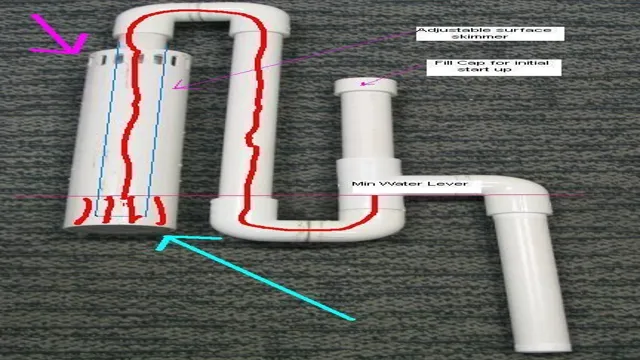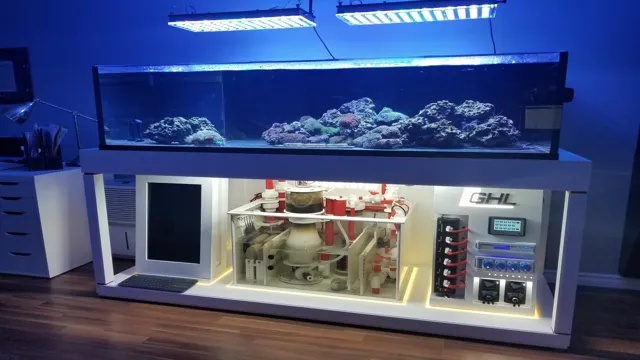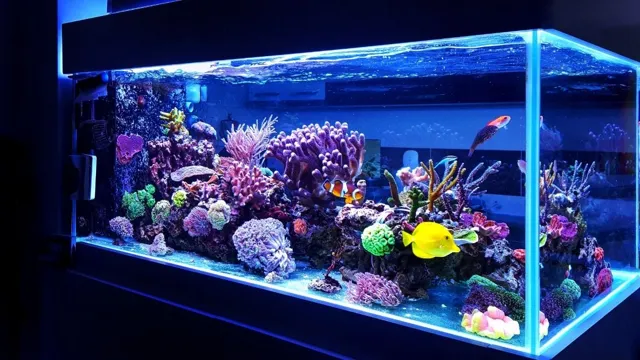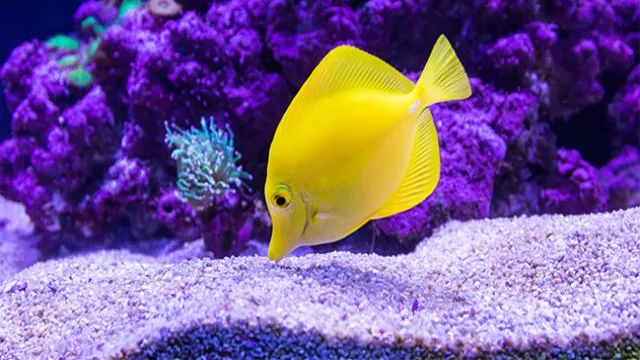Are you tired of dealing with a dirty and clogged aquarium overflow? Not only is it unsightly, but it can also be a health hazard for your fish. Luckily, cleaning your aquarium overflow is a simple process that only requires a few steps. In this step-by-step guide, we will walk you through the process of cleaning your aquarium overflow to keep your tank clean and your fish healthy.
Think of it as giving your aquarium a much-needed spa day. Just like how you would go to the spa to get rid of dirt and toxins in your skin, your aquarium overflow needs a good cleaning to eliminate any buildup of waste and debris. So, let’s dive into the process and get your aquarium looking and feeling refreshed.
Understanding Aquarium Overflow
Aquarium overflow is a critical component of any aquarium setup. It helps maintain a stable water level and prevents flooding. However, it can quickly become clogged with debris and algae, affecting its effectiveness.
To clean aquarium overflow, you need to first turn off the pump and unplug your aquarium. Remove any loose debris using a net or siphon. Then, carefully disassemble the overflow and clean each component thoroughly, including the piping and sponges.
Use hot water and a soft brush to scrub away any stubborn grime, and rinse everything well. Once everything is clean and dry, reassemble the overflow and turn your aquarium back on. Regular maintenance of your aquarium overflow will ensure that it continues to function correctly and protect your precious fish and corals.
What is Aquarium Overflow?
Aquarium overflow is an essential part of aquarium filtration that removes excess waste and debris from the tank. It is a mechanism that diverts water from the main tank to a secondary chamber, where it can be filtered and then returned to the tank. Without an overflow system, aquariums can quickly become unhealthy environments for fish and other aquatic life.
Overflow also helps to maintain consistent water levels, preventing the tank from overflowing or running dry. One example of an overflow system is the use of a sump, a secondary tank connected to the main aquarium that houses various filters and equipment to keep the water clean and healthy for fish and other aquatic life. It is important to have a reliable and well-maintained overflow system to ensure the health and longevity of your aquarium.

Why is Aquarium Overflow Important?
Aquarium overflow is an important aspect that every aquarium owner must understand. It is a mechanism that ensures the water level of the tank remains constant by removing the excess water. The overflow system is crucial as it helps maintain the stability of the system by preventing floods, leaks, and water damage.
In simpler terms, the aquarium overflow acts as a safety valve to the water flow and prevents any potential hazards. Without a reliable overflow mechanism, the aquarium environment would not be sustainable for the animals or plants within it. Therefore, it is vital to understand the aquarium overflow and its importance in maintaining a healthy and safe aquatic environment.
Tools You’ll Need
If you own an aquarium, you know how important it is to keep the water clean and clear for your fish to thrive. One area that often needs attention is the overflow. To clean the aquarium overflow, you’ll need a few tools.
First, you’ll need a bucket to collect any debris or water that you’ll be removing. Second, you’ll need a siphon or gravel vacuum to remove any excess waste or debris that may have built up in the overflow. Finally, you’ll need some tank-safe cleaning solution to sanitize the area and help prevent future buildup.
With these tools in hand, you can easily keep your aquarium overflow clean and free from harmful muck that can harm the delicate ecosystem of your aquarium. Remember, a little cleaning goes a long way in keeping your fish happy and healthy!
Gravel Vacuum
When it comes to performing maintenance on your aquarium, a gravel vacuum is a must-have tool. This handy device allows you to easily remove debris and waste from the bottom of your tank without having to empty the entire thing. But what tools will you need to get the job done? Firstly, you’ll need a gravel vacuum itself.
You can find these in various sizes and styles, so be sure to choose one that fits your tank’s needs. Next, grab a bucket to fill with the dirty water you’ll be siphoning out. You’ll also want to have a hose to connect to your gravel vacuum, as well as a water conditioner to treat the water you’ll be adding back into the tank.
Finally, a pair of rubber gloves can be useful to protect your hands from any sharp objects that may be lurking in your substrate. With these tools on hand, you’ll be able to keep your aquarium clean and healthy for your fish and other aquatic creatures to thrive.
Bucket
Bucket When it comes to gardening, there are some tools you simply cannot do without. One of the most essential items is a bucket. Buckets are versatile and can be used for a wide range of tasks, including transporting soil and compost, carrying water for your plants, and collecting weeds and debris.
They are also useful for mixing fertilizers and other gardening products, and for storing your equipment when you’re finished working. A good quality bucket should be sturdy enough to withstand rough handling and be large enough to hold all of your tools and supplies. When choosing a bucket, look for one with a comfortable handle that won’t dig into your hands when it’s heavily loaded. (See Also: How to Get from Ogilvie Transportation Center to Shedd Aquarium: Easy and Stress-Free Ways)
A brightly-coloured bucket is also a good idea, as it’s easy to spot among all of the greenery in your garden. So if you’re serious about gardening, make sure you have a good quality bucket on hand!
Siphon Hose
If you’re planning on using a siphon hose for any kind of liquid transfer, there are a few tools you’ll need to make sure the process goes as smoothly as possible. First and foremost, you’ll need the siphon hose itself. These are available in a range of sizes and materials, so be sure to choose one that’s appropriate for your needs.
Next, you’ll need a container to hold the liquid you’re transferring, as well as a container to hold the liquid you’re transferring it to. Depending on the type and consistency of the liquid, you may also need a funnel to help guide it into the hose properly. Lastly, you’ll need something to start the siphoning process, which can be as simple as your mouth or as high-tech as a siphon pump.
With these tools in hand, you’ll be well-equipped to handle any siphoning job that comes your way.
Aquarium-safe Cleaning Solution
If you’re looking for an aquarium-safe cleaning solution, you’ll need to make sure you have the right tools on hand. First, start with a good quality siphon hose to help you remove any debris or waste from the bottom of your tank. You’ll also want a gentle cleaning brush, like a soft-bristled toothbrush, to scrub away any algae or buildup on the surface of your decorations or tank walls.
Additionally, a bucket or other container will come in handy for holding your cleaning solution, as well as for holding any fish or other aquatic animals you may want to remove temporarily while you clean. Lastly, don’t forget to use a non-toxic cleaning solution that’s safe for your fish and other aquatic life. With the right tools and approach, you can keep your aquarium looking clean and healthy for all your aquatic friends to enjoy.
So, are you ready to give your aquarium a good, safe cleaning?
Step-by-Step Cleaning Process
If you’re a proud aquarium owner, then you know how important it is to keep your tank clean and well-maintained. One essential component of your aquarium that requires frequent cleaning is the overflow. An aquarium overflow is where excess water in the tank flows out into a separate container or sump, and it’s crucial to ensure that this area is kept clear of debris and build-up.
To clean your aquarium overflow, start by turning off all pumps and powerheads. Next, use a siphon to remove any excess debris or waste from the overflow chamber. You can also scrub the walls of the overflow area with a soft-bristled brush to remove any stubborn build-up.
Finally, give the chamber a good rinse with freshwater, and you’re done! Regular cleaning of your aquarium overflow is vital to avoid blockages and ensure a healthy environment for your aquatic pets. So, don’t wait any longer, get your cleaning gear out and give your overflow chamber the TLC it deserves!
Step 1: Turn off Equipment
Cleaning electronic equipment is essential for maintaining their efficiency, longevity, and safety. But where to begin? The first step of the step-by-step cleaning process is to turn off equipment. Whether it’s a computer, printer, or any other device, make sure to shut it down and unplug it from the outlet.
This is crucial because a sudden power surge or a current could damage the equipment or harm you. Don’t forget to remove any batteries, cables, or other attachments, and place them aside for cleaning. Similarly, make sure that the equipment has cooled down before you begin cleaning because any leftover heat can interfere with the cleaning process.
Now that equipment is switched off and safe to handle, you can move on to the next step. Remember, following these simple steps can save you from unwanted risks and keep your equipment in top-notch condition, ready for use.
Step 2: Remove Debris
Now that you’ve cleared the area of any loose items, it’s time to remove any debris that has accumulated on the surface. This means any twigs, leaves, dirt, or other debris that may have collected on your outdoor space. To begin, grab a broom or a brush and start sweeping the area.
Work your way from one end of the area to the other, making sure to sweep up every bit of debris. You can also use a leaf blower to help clear away larger amounts of debris quickly. If there are any stubborn patches of dirt or grime, you may need to use a pressure washer to get rid of them.
Just be sure to use the appropriate pressure level to prevent any damage to the surface. By removing all debris, you’ll be able to thoroughly clean your outdoor space and make it look its best. (See Also: How to Clean Live Rock in Aquarium: Essential Tips for a Sparkling Tank)
Step 3: Clean the Overflow Box
Cleaning the overflow box of your aquarium is crucial for the health and well-being of your aquatic pets. The overflow box is responsible for removing dirt, debris, and uneaten food from your aquarium to maintain a clean and healthy environment for your fish and other aquatic animals. To clean the overflow box, start by turning off the filters and pumps to ensure that there is no more water flow.
Use a brush or a toothbrush to clean the inside and outside of the box, removing any dirt or debris buildup. Make sure to rinse the box with clean water thoroughly before re-assembling it and turning the pumps and filters back on. By cleaning the overflow box regularly, you can prevent clogs and other issues, ensuring that your aquarium remains a thriving home for your aquatic pets.
Step 4: Clean the Return Pipe
Cleaning the return pipe is a crucial step in maintaining a well-functioning HVAC system. Over time, the return pipe can accumulate dust, dirt, and debris, which can hinder the system’s performance and affect the indoor air quality. To clean the return pipe, you will need to turn off the power to the system, remove the grille, and vacuum the inside of the pipe using a high-powered vacuum.
You can also use a stiff brush to loosen any stubborn dirt or debris that may be stuck inside the pipe. It’s important to be gentle and not damage the pipe while cleaning it. Once you have thoroughly cleaned the pipe, you can reattach the grille and turn the power back on to the system.
Regularly cleaning the return pipe will keep your HVAC system functioning at optimal levels and promote better indoor air quality.
Step 5: Clean the Pump
When it comes to keeping your pump in tip-top shape, cleaning is essential. Here’s a step-by-step process to ensure that your pump is cleaned properly. First, remove the pump cover and inspect it for any signs of damage.
Next, remove the impeller and inspect it carefully for any signs of wear or damage. Now it’s time to clean the pump housing and impeller thoroughly. You can use a soft bristle brush to remove any debris or buildup.
Once the impeller and housing are clean, it’s time to reassemble the pump. Finally, turn the power back on and test the pump to make sure it’s working efficiently. Regular cleaning of your pump will ensure that it lasts longer and works efficiently, saving you time and money in the long run.
Remember, proper maintenance is key to prolonging the life of your pump, so make sure you take the time to keep it clean and well-maintained.
Step 6: Reassemble and Test
As you complete the previous steps of dismantling and cleaning the various parts, it’s time to put everything back together to test your hard work. Begin by screwing all the different components back together, ensuring you don’t miss any screws or connections. Once everything’s in place, pour some water or cleaning solution into the tank and let it run for a few minutes, checking for any leaks or issues in the process.
If there are no leaks observed, you’re good to go. Meanwhile, if you still find a leak, it’s recommended you disassemble the parts once again and look for the problem area before trying again. A properly cleaned humidifier ensures maximum efficiency, reduces respiratory problems and eliminates bacteria.
Get your humidifier to work smoothly just in time for the winter season!
Preventative Measures
Keeping your aquarium overflow clean is crucial as it can prevent disasters from happening. One way of cleaning it is to take preventative measures such as monitoring the water level regularly and making adjustments accordingly. Be sure not to overfill the aquarium water as it can result in an overflow and buildup of stagnant water in the overflow box.
Therefore, it’s best to leave a gap between the water level and the overflow box. Another preventative measure is to incorporate a sponge filter into the overflow box, which will help trap any debris and prevent it from being pumped into the main tank. With regular monitoring and simple preventative measures such as these, cleaning your aquarium overflow can be an easy task that saves you time and money in the long run.
Regular Maintenance
Regular maintenance is crucial if you want to prevent costly repairs to your home appliances and systems. Taking preventative measures can save you money in the long run and ensure that your appliances and systems operate efficiently for longer. Some of the common preventative measures include regular cleaning, checking for worn-out parts, and replacing them when needed. (See Also: How to Get to Sydney Aquarium from Parramatta: Quick and Easy Route)
Regularly cleaning your appliances and systems can help prevent dust and dirt buildup which can cause breakdowns. It is also essential to check for any signs of wear and tear, such as frayed cords or leaks, and replace them before they cause any further damage. Additionally, ensuring that your appliances or HVAC systems undergo regular service appointments will help identify potential issues early on and prevent more significant problems down the line.
Maintaining your appliances and systems regularly reduces the risk of breakdowns, maximizes energy efficiency, and extends their lifespan, all while saving you money.
Invest in a Skimmer
If you’re a pool owner, investing in a skimmer is an important preventative measure to keep your pool clean and well-maintained. Skimmers work by removing debris that floats on the surface of the water, such as leaves, grass clippings, and bugs. This not only improves the appearance of your pool, but also reduces the risk of clogs in your filters and pumps, which can lead to costly repairs.
Make sure to choose a skimmer that is appropriately sized for your pool and that is made of durable materials to ensure it lasts. By investing in a skimmer and regularly cleaning it out, you can enjoy a crystal-clear pool that is free of debris and ready for swimming. So, why wait? Take the first step in protecting your investment today by adding a skimmer to your pool maintenance routine.
Conclusion
In short, keeping your aquarium overflow clean and functioning properly is vital to the health and longevity of your aquatic pets. It may seem like a daunting task, but with a few simple steps and regular maintenance, you can maintain a clean and healthy environment for your fishy friends. Remember, a little effort now can save you a lot of headaches (and possibly heartaches) down the road.
So, don’t let that overflow overflow, keep it clean and enjoy your underwater oasis with ease!”
FAQs
What is an aquarium overflow and why is it important to keep it clean?
An aquarium overflow is a device that helps maintain proper water level in the aquarium and prevent overflow. It is important to keep it clean to prevent clogging and ensure efficient water flow.
How often should I clean my aquarium overflow?
It is recommended to clean your aquarium overflow at least once a month to prevent debris buildup and ensure proper water flow.
What tools do I need to clean my aquarium overflow?
You will need a cleaning brush, tubing, and a bucket.
Can I use soap or cleaning chemicals to clean my aquarium overflow?
No, it is not recommended to use soap or cleaning chemicals as they can leave harmful residues that can harm your aquatic pets. Use only freshwater.
How do I clean the tubing of my aquarium overflow?
You can use a cleaning brush to scrub the inside of the tubing with freshwater until all debris is removed.
How do I prevent my aquarium overflow from clogging?
You can prevent clogging by avoiding overfeeding, removing excess debris from the aquarium, and regular cleaning of the overflow.
Can I hire a professional to clean my aquarium overflow?
Yes, you can hire a professional to clean your aquarium overflow if you are not comfortable doing it yourself. Just make sure to hire a reputable and experienced professional.







